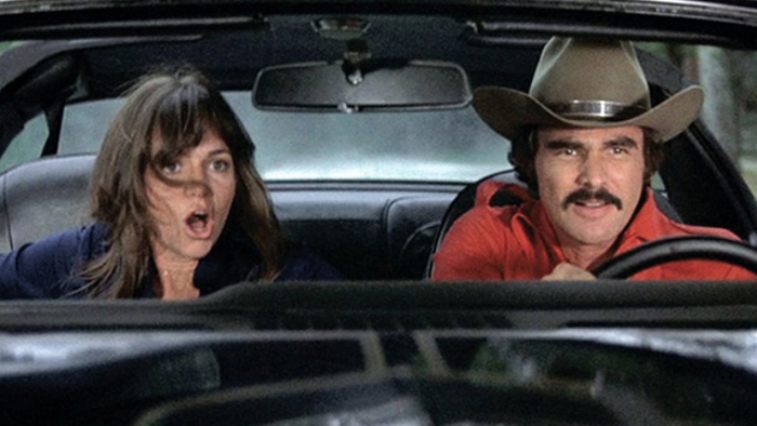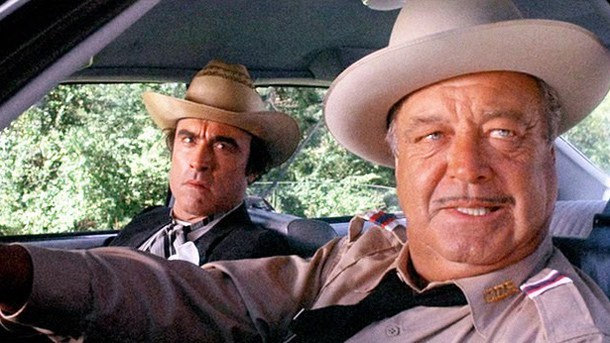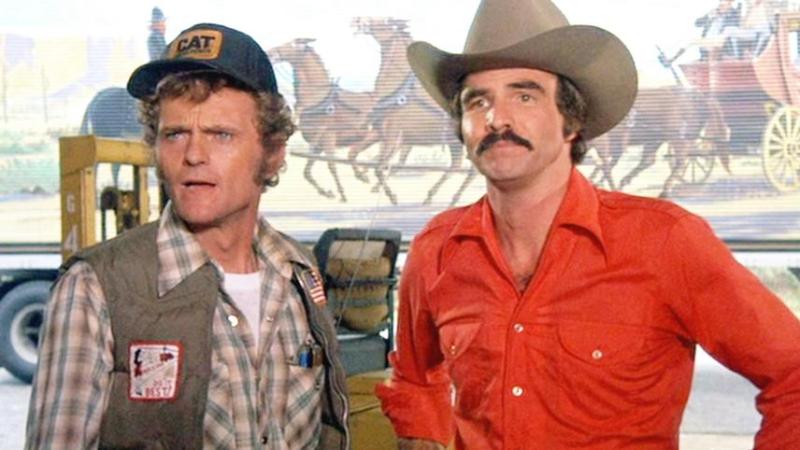In Loving Memory of Burt Reynolds.
I just got outta the cheapest choke n’ puke I could find and hopped in my Jimmy and barreled down the highway sipping on hundred mile coffee. The car in front of me was some ol’ dung beetle and I knew it’d be my luck if I passed him and put my pedal to the floor and I feared a kojak with a kodak was gonna see me and snatch me up good.
I’m sorry, guys. Every time I see this film the language and culture of the old American highway comes through my fingers and into the keyboard. It infects my soul. You’ve got your gimmicks used to cash in on the fad from back in the day (god, do I need to explain what a CB radio is in this review?) but Smokey and the Bandit is way more than a cash-in. It’s probably what’s going to endure the ages and be relevant far into the future when Amazon drones drive our big-wheelers.

Smokey and the Bandit is a short, fun movie that features a lot of comedic scenes and a lot of car stunts. It’s about a former outlaw trucker who goes by the handle Bandit (Burt Reynolds) taking a ridiculous offer to run to Texarkana to pick up 400 cases of Coors beer and bring them over state lines into Georgia in twenty-eight hours. This movie is dated to its time in multiple ways; first is the actual premise: the reason this is dangerous is because over the state lines in Georgia running that kind of beer without a permit was bootlegging at the time. The reward to the Bandit of $80,000 seems ludicrous to anyone outside that current location at that current time. The other way is the language and culture of the film that are long gone but still feel warmly familiar. The culture is rooted in trucking and CB radio communications—which were a public way of traffic communication and had its own attitude and lingo—as well as a Southern flair that I think is lost in this current generation.
Accompanying Bandit are Frog (Sally Field) and Snowman (Jerry Reed). Chasing Bandit throughout the second half of the run is Texas Sheriff Buford T. Justice (Jackie Gleason). This cast is phenomenal and definitely elevates the film beyond the subject matter and script allow.
Reed’s Snowman is particularly enjoyable. The character is reliable in every sense of the word, and Reed’s own written and performed music for the film is fantastic and absolutely makes the film in so many ways. It’s funny that the start of the film is a Reed song explaining “the legend” of the Bandit, but it works. It tells you what you need to know, is super catchy, and is the kind of ballad meant to build up myths like that. Eastbound and Down is an even more famous song and captures the fun of the film.
Frog is a sort of love interest who belongs in this kind of movie and should be seen more in films. She’s a dissatisfied performer and a runaway bride, and her relationship with Bandit is founded on the feeling they have together. Not much else, and that’s okay. Multiple scenes feature her unsure about the Bandit and her relationship with him, and she even questions, “Do we have a single thing in common?” She quizzes him on Broadway showtune musicians; Bandit quizzes her on Country musicians; and neither know anything about the other’s world. Bandit eases her doubts, however, when he imparts this wisdom: “When you tell somebody something, it all depends on what part of the country you’re standing on to just how dumb you sound.”

Gleason is clearly a comedic force of nature as Justice. I’m from the South and parts of the culture disappoint me and parts I think are perfectly redeemable. I think currently the South embraces the ugliest parts of itself without self criticism. There’s no symbols of the Confederacy here (to my recollection at least), and while the Southern outlaw is glamorized—it works. You root for the heroes, and Justice as the antagonist is delightfully repugnant. This is what I feel is missing in the South now, and this is the core of the film. Bandit’s mysterious charisma is matched against Justice’s position and persistence. Police in the film, and particularly Justice, are portrayed as disgusting, corrupt and bumbling. They pull rank and seek desperately to hold onto established order. The one moment of explicit racism (contrasted by the friendly racial atmosphere Bandit and Snowman share with strangers) is when Justice notices an African-American police officer and asks, “What is the world coming to?” Justice and his son in many ways represent what’s wrong with American law enforcement, and it’s totally beautiful to see that in a film that has strong southern pride. He’s also really funny, mean, and the best part about him is that his persistence to catch the Bandit is heroically admirable. You like one singular thing about him, and the rest is rotten to the core.
And then there’s Burt Reynolds. I’m writing this not long after I’ve heard of his passing, and I can’t express in enough words how sad I am about it. Reynolds never had the stellar, critically acclaimed career he wanted, but from what he starred in he was not only charismatic and iconic, but his dramatic performances showcased his versatility. Deliverance was a landmark title, and Lewis Medlock was far from Reynolds’ cinematic personality. He delivered quality work in voice acting such as All Dogs Go to Heaven (a particular Bluth production I’m fond of) and even gave Academy-worthy work in films he didn’t actually like or agree with, such as Boogie Nights. He was a symbol for masculinity in a time where masculinity started to be questioned and broken down. He’s the best looking guy to ever sport a mustache. Being a modern, stick-shift cowboy is almost impossible without Reynolds. Nobody drove a car with a smile better than him.
Even in low-effort appearances from the past two decades, he still gave sound performances that did not reek of laziness. From clever homages as major roles like in The Dukes of Hazzard (which is a movie based on a show that tried really hard to be Smokey and the Bandit) to outright indulgent cameos in modern pop culture hits like Archer and Saints Row, he’s irreplaceable. There’s two more movies slated to feature him: Tarantino’s Once Upon a Time in Hollywood and a lower budget affair in Defining Moments.

And to talk about his performance specifically as the Bandit, he delivers the charm in aces.
The movie ticket is sold on Reynolds. That’s why you’re watching this; that’s why you’re reading this.
His personality and delivery capture the character and tone of the scenes more than perfectly, and more importantly he’s absolutely magnetic to watch on screen. The absolute best is early in the film when he outruns a cop before they pick up the beer, and he looks at the camera and smiles. It’s priceless. His attitude matches how the audience should shape their sensibilities: this is a ride, and we’re going to make it there as fast and as fun as possible.
The actual car chases are fun enough, but I think the film falls too much on the “stupid cops follow Bandit somebody calls him on his CB tells him they’re setting up a trap and now the cops fall for it” formula. It’s okay, but you start to notice it near the end, and it’s definitely not the most graceful way to end car chases. Oh, also: the Pontiac Trans Am is a beautiful car. Seeing it do the stunts in this film is wicked satisfying. Particularly in the comedic portion where Frog is the one driving and the car does a bunch of U-turns and goofy donuts. Looks amazing even when what’s going on is a mess.
The film isn’t a masterpiece by any stretch of the imagination. It’s not even Reynolds’ best work. It’s what he might be most remembered for by the public though and that’s okay. It’s a slice of fun and Americana that just doesn’t exist anymore. Cynicism isn’t here, speed is.
So I’m filled up on go-go juice and gonna head out, good buddies, got a long drive ahead. Wish you good numbers and I hope to see you all (and Burt too) another time.
